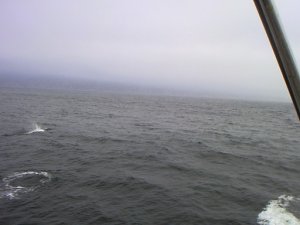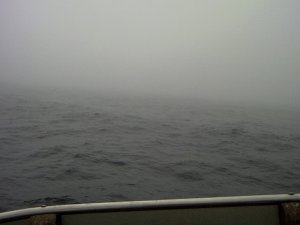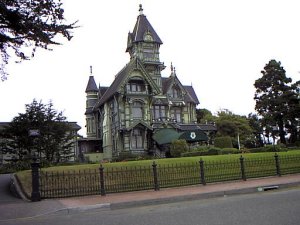Cuffey Cove to Eureka, Humboldt Bay
August 28, 2000
Anchoring in the open water keeps one on a level of alertness that
precludes getting a good night's sleep. This is the way it is and probably explains why
there aren't a lot of solo trips made up and down this coast. To do otherwise would tax
the best sailor. Our night at Cuffey Cove was one of those taxing nights. The waves rolled
in from the west all night, rolling the boat as if we were under way and challenging the
anchor to stay where it was placed.
I was up all night checking our position. As it was, when the sun came up
in the morning we had moved about 30 feet. I still don't know how much the rising and
falling tides have to do with this, but it's certainly a factor. Anyway, I wasn't too
displeased with the anchorage.
After Debbie had her coffee and we had our showers, we weighed anchor and
headed out for our next leg - Eureka, 100+ nautical miles away. This would be our longest
leg since leaving San Diego.
Swells were coming from the west at about 10-12 seconds apart. They were
large today, probably up to 10 feet, but were coming at us at such a frequency that the
ride was not too bad.
 We made our way up the coast with the refreshing boredom that comes
with piloting the ship without a pending crisis. The NOAA reports in the morning promised
respectable conditions and for once, our anxiety eased a bit. Though we've learned to
never let our guard down, we were certainly feeling better at the beginning of this leg
than we did about the one yesterday morning. Of course, Punta Gorda (
We made our way up the coast with the refreshing boredom that comes
with piloting the ship without a pending crisis. The NOAA reports in the morning promised
respectable conditions and for once, our anxiety eased a bit. Though we've learned to
never let our guard down, we were certainly feeling better at the beginning of this leg
than we did about the one yesterday morning. Of course, Punta Gorda (I've never seen
it good
the fisherman in Half Moon Bay told us.) and Cape Mendocino were many hours
away. No use worrying about them now. At eight knots we would have plenty of time to worry
about them later.
Passing Fort Bragg reinforced our decision to not attempt that entrance at
night. The entranced looked awful skinny looking at it from the seaward vantage. Though
the area around the entrance is referred to as Noyo Anchorage, it didn't look much like an
anchorage to us. Getting there at night would have not left us with much choice but to
cross the bar leading to the marina on the Noyo River. Naw, we're not experienced
enough for that.
The weather improved as we headed on a direct course to Punta Gorda.
Passing Shelter Cove (another anchorage) we saw the place we would turn around for if the
weather turned nasty up ahead. But it didn't. Passing Punta Gorda was as easy as the seas
we had already sailed - calm except for the gentle rolling of the swells.
Up ahead lay Cape Mendocino. Calculating our time to Humboldt Bay, we were
beginning to see that we would not make it till well after dark. Based on that, we decided
to go through Blunt's Reef off the coast of Cape Mendocino rather than the five miles or
so we would have to go out of our way to pass outside of the buoy marking the reef. The
charts didn't show any serious threats to our navigation of the reef. Nevertheless, the
recommendation in our chart guide to not cut this corner weighed on our minds. But we went
for it anyway.
To make matters worse, after we had already committed to going through the
reef, and we're in a position that left us no option but to continue ahead or turn around,
the fog rolled in. This was no ordinary fog either, this was the proverbial pea soup!
Debbie referred to it as two wave fog
, since that was all the farther we could
see.
 I had joked many times in the past that fog
was pretty irrelevant in a ship that moves at eight knots. And while that was mostly true -
we could stop or avoid anything is a pretty short distance - it didn't relieve the anxiety
that comes with limited visibility. As we made our way around Cape Mendocino, certain that
the fog would lift after our passage, we became more aware that we weren't going to make the
entrance to Eureka before sunset. How long after sunset was a matter of conjecture, as our speed was
diminishing at the time of passing Cape Mendocino. With sunset at 7:55, it looked like we
would make it to the entrance at about 8:15 to 8:30.
I had joked many times in the past that fog
was pretty irrelevant in a ship that moves at eight knots. And while that was mostly true -
we could stop or avoid anything is a pretty short distance - it didn't relieve the anxiety
that comes with limited visibility. As we made our way around Cape Mendocino, certain that
the fog would lift after our passage, we became more aware that we weren't going to make the
entrance to Eureka before sunset. How long after sunset was a matter of conjecture, as our speed was
diminishing at the time of passing Cape Mendocino. With sunset at 7:55, it looked like we
would make it to the entrance at about 8:15 to 8:30.
The fog didn't lift after we cleared Cape Mendocino - if anything, it may
had even gotten thicker. We stayed on course with the GPS leading us to the entrance buoy,
frequently going below to check the radar. As we approached Eureka, with the GPS showing
us less than half a mile from the buoy, we still couldn't see a thing. We could hear the
buoy, we just couldn't see it. Finally, at about a quarter of a mile the buoy came into
sight. But it didn't offer much comfort, as the visibility was so limited that we couldn't
see the jetty it marked. So we went in on radar, slowly, splitting the north and south
jetties, watching and listening for breakers and channel buoys. It helped that the GPS
chartplotter showed the buoys and that they also showed up on radar ("I think that
blot there is a  buoy?"). But what really helped was the
tug boat that came from astern to pass us in the channel. While we could we followed him. As
we got farther into Humboldt Bay the fog lifted to a visibility of about a mile. More than
enough to see the buoys and markers.
buoy?"). But what really helped was the
tug boat that came from astern to pass us in the channel. While we could we followed him. As
we got farther into Humboldt Bay the fog lifted to a visibility of about a mile. More than
enough to see the buoys and markers.
We came up to a moorage after about two miles, made the decision to stay
there, and took the first open slip. OK, so it wasn't exactly a 40' slip, and we stuck out
about 5 feet, but it was home for the night. We hooked up the power (yeehaw, hot water
showers!), filled the water tank and settled in for a more peaceful night than that at
Cuffey Cove. I was asleep in no time at all.
Things were progressing well. Tomorrow we would shoot for Brookings,
Oregon and say goodbye to California.
 We made our way up the coast with the refreshing boredom that comes
with piloting the ship without a pending crisis. The NOAA reports in the morning promised
respectable conditions and for once, our anxiety eased a bit. Though we've learned to
never let our guard down, we were certainly feeling better at the beginning of this leg
than we did about the one yesterday morning. Of course, Punta Gorda (
We made our way up the coast with the refreshing boredom that comes
with piloting the ship without a pending crisis. The NOAA reports in the morning promised
respectable conditions and for once, our anxiety eased a bit. Though we've learned to
never let our guard down, we were certainly feeling better at the beginning of this leg
than we did about the one yesterday morning. Of course, Punta Gorda ( I had joked many times in the past that fog
was pretty irrelevant in a ship that moves at eight knots. And while that was mostly true -
we could stop or avoid anything is a pretty short distance - it didn't relieve the anxiety
that comes with limited visibility. As we made our way around Cape Mendocino, certain that
the fog would lift after our passage, we became more aware that we weren't going to make the
entrance to Eureka before sunset. How long after sunset was a matter of conjecture, as our speed was
diminishing at the time of passing Cape Mendocino. With sunset at 7:55, it looked like we
would make it to the entrance at about 8:15 to 8:30.
I had joked many times in the past that fog
was pretty irrelevant in a ship that moves at eight knots. And while that was mostly true -
we could stop or avoid anything is a pretty short distance - it didn't relieve the anxiety
that comes with limited visibility. As we made our way around Cape Mendocino, certain that
the fog would lift after our passage, we became more aware that we weren't going to make the
entrance to Eureka before sunset. How long after sunset was a matter of conjecture, as our speed was
diminishing at the time of passing Cape Mendocino. With sunset at 7:55, it looked like we
would make it to the entrance at about 8:15 to 8:30. buoy?"). But what really helped was the
tug boat that came from astern to pass us in the channel. While we could we followed him. As
we got farther into Humboldt Bay the fog lifted to a visibility of about a mile. More than
enough to see the buoys and markers.
buoy?"). But what really helped was the
tug boat that came from astern to pass us in the channel. While we could we followed him. As
we got farther into Humboldt Bay the fog lifted to a visibility of about a mile. More than
enough to see the buoys and markers.